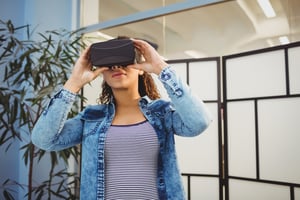After years of buildup, wearable technology is revolutionizing our lives, particularly in the health industry. With the introduction of more affordable solutions, these technologies are beginning to see a shift into new niches—including the education sphere. Projected to become a mainstream commodity in schools within 3 years, wearable technology offers teachers and students a variety of new learning tools. Keep reading to learn about four types of wearable technology and how they can be integrated into the curriculum.
Activity Trackers
 Activity trackers, like the FitBit or the Heart Zones System, are designed to measure and record users’ bio-metric data. One of the main advantages to using activity trackers in education is that they provide a pathway for students to learn about how their bodies interact with their surroundings. In health or physical education classes in particular, these devices provide interactive ways for students to monitor their fitness. Activity trackers also allow students to set their own personalized fitness goals, meaning teachers can easily tailor the lesson plan to suit each student’s individual strengths and weaknesses.
Activity trackers, like the FitBit or the Heart Zones System, are designed to measure and record users’ bio-metric data. One of the main advantages to using activity trackers in education is that they provide a pathway for students to learn about how their bodies interact with their surroundings. In health or physical education classes in particular, these devices provide interactive ways for students to monitor their fitness. Activity trackers also allow students to set their own personalized fitness goals, meaning teachers can easily tailor the lesson plan to suit each student’s individual strengths and weaknesses.
Asking students to use these devices at home also encourages students to lead healthier lifestyles outside of the classroom. For example, homework assignments aimed toward tracking mood or sleep patterns could help students identify stress triggers, or even the time of day they are most productive. Students can use this information, in turn, to help balance their lives—which could also lead to improvements in academic performance over time.
Smart Watches
On top of their bio-metric capabilities, smart watches also offer an assortment of other functionalities useful to schools. Smart watches can help keep students accountable for their assignments, since they provide quick ways to log calendar events, create speech-to-text notes, and set reminders for important assignment deadlines.
In math class, students who forget their calculators can use the built-in calculator on their smart watch as a temporary back-up. A smart watch’s search engine capabilities can also be used to look up equations, or watch instructional videos. At home, students can use its clock and built-in timer to help manage the time they spend studying. The communicative capabilities of smart watches also offers a means of support to students, letting them reach out to their teachers for help or collaborate with peers.
Virtual Reality
 Unfortunately, not all field trips are covered by the budget. With virtual reality, however, students can immerse themselves in nearly any environment for a fraction of the cost (and without leaving the classroom!). Applicable to a seemingly limitless variety of subjects, students can find themselves in far-away locations including foreign countries, outer-space, or even the depths of the ocean. What better way to encourage student engagement?
Unfortunately, not all field trips are covered by the budget. With virtual reality, however, students can immerse themselves in nearly any environment for a fraction of the cost (and without leaving the classroom!). Applicable to a seemingly limitless variety of subjects, students can find themselves in far-away locations including foreign countries, outer-space, or even the depths of the ocean. What better way to encourage student engagement?
Additionally, educators can challenge students to develop their own virtual reality experiences. This puts the students at the forefront of their own learning experiences and encourages them to take their own initiative. For more information on virtual reality development, check out this blog post on creating virtual reality in the classroom.
Smart Glasses
Smart glasses are the hands-free version of a tablet or smartphone device. In the classroom, students can use them to record lessons, take notes, communicate with peers, and also as a virtual reality headset. For those who are absent, teachers can use the integrated camera to record, or live-stream, the lesson to students so they avoid falling behind.
The camera feature also enables students to take photos and record videos, or audio, for class projects or presentations. By incorporating student experiences into assignments, students will have an easier time relating to the lesson content. Consequently, smart glasses can encourage student creation, while also increasing student engagement and content retention.
Still smoothing out logistics and finding their place in the market, smart glasses may be a bit over-budget for the average school district—for the time being. Despite this, it would be a shame to ignore the contributions that smart glasses might bring to the future of education. As soon as they become more affordable, however, there is no question that smart glasses will have their time. For now, we can focus on what activity trackers, smart phones, and virtual reality head have to offer.
Nobody can ignore the growing interest in wearable technology and the powerful ways it might transform the future of education, but there are still many questions left unanswered. For example, how will teachers and students manage these devices? Will 1-to-1 wearables, such as smart watches, ever be provided to students by schools? Or will the integration framework follow a bring your own device (BYOD) design? Let me know what you think by submitting a comment below!
 Get More Cost-Effective Charging and Storage for Your Devices
Get More Cost-Effective Charging and Storage for Your Devices
Flex-Share Charging Stations are modular charging solutions that can be configured in multiple ways to best satisfy the charging requirements and space limitations in each classroom. Charging and securing up to 16 devices each, these charging stations offer a variety of installation options that help maximize classroom space and improve the flow of student traffic when deploying devices. Click below to watch a video about Flex-Share Charging Stations and request more information or a quote!


